Last updated on May 3rd, 2023
57. Formicarium
Formicarium, Latin for “ant farm”, is a colony between panes of glass for ease of observation. French entomologist Charles Janet earned knighthood for this invention.
58. Mass Market Farms
In the 1950s, Uncle Milton’s Ant Farm became a commercial success. These were marketed as educational toys to help kids learn about fascinating insect behaviors.
59. US Prohibition
US federal law prevents interstate shipment of live queen ants. If you want to start a colony, then buy a queen of a native species from a local vendor.
60. Fill Material
Most ant farms are filled with soil, sawdust, sand, or mineral fragments. Some have clear edible gel with sugar or agar. Containers have a slippery coating to prevent escape.
Ants in Culture
61. Book of Proverbs
The Bible lauds ants as small yet wise creatures. They work together to diligently store food throughout summer, which helps them survive the winter.
62. The Ant and the Grasshopper

In Aesop’s fable, the grasshopper made music while the ants dried grain. In the winter, the lazy grasshopper begged for food, but the ant told it to dance and left.
63. Ants in the Quran
The 27th chapter is called The Ant. In Verse 18, an ant told the colony to seek shelter so they won’t be crushed by Solomon.
64. Hopi Mythology
According to Hopi Indian legend, the ancient world was destroyed by fire and ice. Their ancestors survived thanks to the Ant People who sheltered them in underground caves.
65. African Mythology
After Bumba created the world, his son Nyonye Ngana tried to make ants. However, the effort drained his life. Grateful ants continue to dig the earth to give him a proper burial.
66. The Empire of the Ants
In 1905, famous science fiction author H.G. Wells wrote a short story about intelligent ants in South America destroying settlements and threatening human civilization.
67. Starship Troopers
Robert Heinlein wrote “Starship Troopers” during the Cold War, wherein the human Terran Federation clash against ant-like Bugs. It explores themes such as democracy, communism, war, and punishment.
68. SimAnt Video Game
Want to control your own colony? SimAnt features black ants fighting against red ants in a suburban backyard battlefield. It won the Codie award for Best Simulation Program in 1992.
69. 3D Ants
In 1998, Dreamworks and Pixar had a feud over ants. They released similar animated films: “Antz” and “A Bug’s Life”. These hits featured the voices of Jennifer Lopez, Sylvester Stallone, and Kevin Spacey.
70. Ant-Man
In 2015, Ant-Man leapt from comics to the big screen featuring Paul Rudd. With a super-suit that shrinks and strengthens, the burglar becomes a hero who saves the world.
Types of Ants
1. Fire Ants

Fire ants are also known as thief ants and are mainly found in Central and South America. They are also found in parts of North America where the temperature is mild and was accidentally brought to the United States from South America.
Fire ants are most commonly red, which is where the name came from. Some fire ants are yellowish in color and can grow to be one to five millimeters in length.
Fire ants can inflict a painful sting when disturbed or they feel threatened and are known for damaging grain in the fields and attacking chickens and turkeys.
Fire ants are omnivorous and feed on insects, ticks, spiders, earthworms, and arthropod eggs. They also feed on honeydew and other sweet fruit.
These ants can communicate through chemical secretions and the sounds they produce by rubbing or drumming one part of their bodies on another.
Adult fire ants are aggressive and will fight when threatened. Young fire ants have stingers and external skeletons that aren’t fully developed, so they play dead when threatened and allow the adults to handle the fight.
2. Black Garden Ants
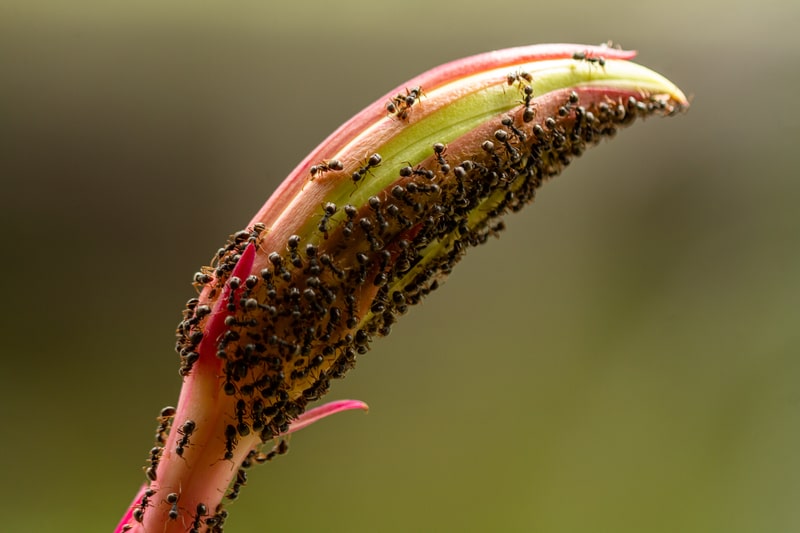
Black garden ants are often found in gardens, which is where the name comes from.
It’s also not uncommon to find black garden ants searching for something sweet to eat in your house.
Adult black garden ants have wings and swarm together in large numbers.
When the ants mate during the summer, they will move on to form a new colony. There are thousands of black garden ants in a colony, and they all have jobs. The ants in the colony perform different jobs, such as collecting food, keeping the nest clean, and caring for the young. There’s a queen who produces eggs.
The black garden ant lives in many places, such as gardens, nests, under paving stones, in the soil, and between bricks.
A fire ant’s diet varies; one of their favorite food sources is aphids, and the ant will milk the aphid to get its honeydew.
3. Pharaoh Ants

The Pharaoh ant got its name because people mistakenly believed that these ants were one of the plagues in ancient Egypt.
These ants are found all over the world and are believed to have originated in Africa. These ants don’t build nests outdoors in colder climates but have learned to adapt to the southern Florida climate. In colder areas, they nest in heated buildings.
The Pharaoh ant can grow to 1.5 to 2 millimeters in length and have 12 segments.
Like all ants, Pharaoh ants live in colonies. The colonies consist of workers, males, and queens, along with eggs, larvae, pre-pupae, and pupae.
These ants are picky about their nesting areas. They typically seek out places that are 80 to 86 degrees, with 80 percent humidity. They’ll also find a location close to food and water sources, such as voids within a wall.
The size of a colony varies from a couple of dozen ants to thousands or hundreds of thousands.
Pharaoh ants don’t swarm during mating, and mating takes place in the nest. In some cases, a queen will take males and workers to create a new colony.
4. Argentine Ants

The first Argentine ant was found in Argentina, which is where it got its name.
The Argentine ant is a very invasive species and is native to northern Argentina, Bolivia, Paraguay, Uruguay, and southern Brazil. They can also be found in New Zealand, Japan, Australia, Easter Island, South America, Europe, Hawaii, and the continental United States.
The worker ants grow to be 1.6 to 2.8 millimeters in length, which allows them to squeeze into tiny spaces like cracks in concrete, between boards, and into homes. The queens grow to 4.2 to 6.4 millimeters, which is smaller than many queens of other species.
Unlike many other species of ants, Argentine ants don’t attack other colonies, and they often communicate and work with ants in other colonies because they are very social insects.
Some Argentine ants will create a super-colony, where conflict can occur.
The Argentine ant’s diet varies, and they feed on cakes, sweet drinks, meat, dead insects, and pet food.
5. Pavement Ants

Pavement ants get their name because they make their nests in cracks in the pavement and can infest other structures.
These ants are found throughout the Atlantic coastal region, and they’re also located in the mid-western United States, on the West Coast, and some are found in the southern United States.
The pavement ant is tiny and grows to around 1/8 of an inch. They are either brown or black and have six legs.
These ants eat just about anything and are known to eat seeds, insects, honey, bread, honeydew, nuts, cheese, and meats. When foraging for food, the pavement ant will travel 30 feet and climb masonry walls to enter buildings.
Pavement ants don’t cause damage or pose a public health risk; however, they can contaminate food and drinks in your home. If you understand more about ants, it’s easier to keep them out of the house.
6. Carpenter Ants

Carpenter ants are found worldwide, and there are many different species.
The ant was named in 1773 and was the first ant to be named in North America, and they are most common in the eastern United States and southeastern Canada.
Carpenter ants are black and are one of the larger types and can grow to be ¼ inch to ½ inch in length.
These ants can fly, and they swarm in the spring, which is a sign of a colony nesting nearby.
The most common places for nests include dead or dying trees, dead branches, and stumps. They also nest in building materials weakened by moisture, such as sheds, houses, and lumber piles, and some species nest in the soil.
It’s easy to confuse carpenter ants with termites because both are found in wood and burrow into the wood to go deeper and deeper. The most significant difference is in the appearance, and the ants are bigger than termites and the shape of their waist, wings, and antennae differ from a termite’s.
There are two different types of carpenter ant colonies.
The first is a parent colony, which includes a queen to lay eggs, brood, and about 2,000 worker ants.
The second is a satellite colony with many worker ants but no queens, young larvae, or eggs. Not all worker ants will leave for the satellite colony because the queen will need workers to find food, protect the colony, and to keep the nest clean.
Carpenter ants will travel up to 300 feet to forage for food, and their primary diet includes plant and fruit juices, insect honeydew, smaller insects, and arthropods.
Because carpenter ants travel so far for food, it isn’t uncommon for them to get into your home during the search. When they enter your house, they’ll look for sweets, meats, eggs, and grease.
7. Odorous House Ants
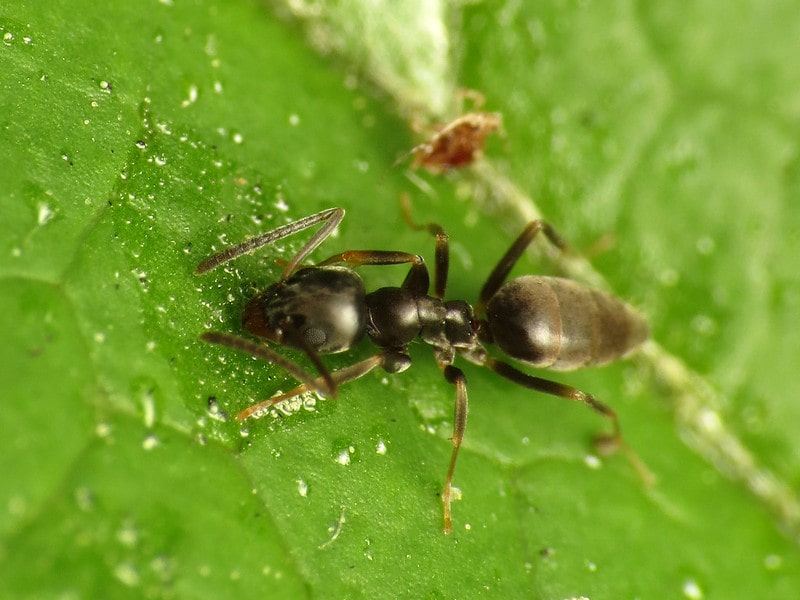
The odorous house ant is native to the United States, as well as southern Canada and Mexico, and are the second most common house pest managed by exterminators.
The ant is dark brown to black and grows to be about 1/8-inch long. The odorous house ant gets its name because it smells like rotten coconut, and you may notice other odors when crushed.
This ant creates a nest in various habitats and is often found in shallow nests under wood, stones, or other debris. You can also find them in wooded areas, at the beach, in voids of the wall, or around heaters and water pipes.
Like all other ants, the odorous house ant lives in a colony, and they prefer large colonies with several queens and up to 10,000 workers, which is larger than many other ant colonies.
Ants that nest outdoors feed on live or dead insects and prefer scale honeydew and aphid. If the ants get into the home and nest indoors will typically forage for sweets.
8. Ghost Ants
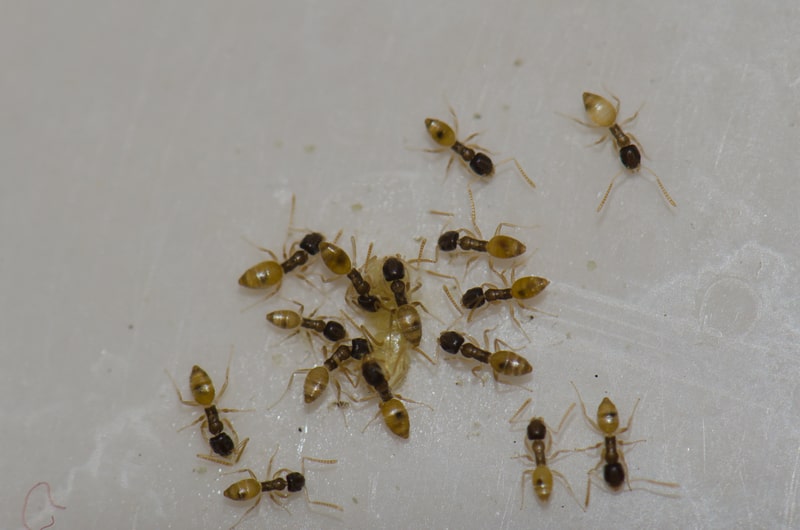
Ghost ants are very widespread, and their native area is unknown.
Ghost ants are a tropical species and cannot adapt to colder climates.
In colder climates, ghost ants are only confined to buildings with heat and greenhouses and won’t survive outside in the cold weather.
In the United States, ghost ants are most often found in Florida and Hawaii. They are also found in parts of Texas, but the ghost ant is less common there.
The ghost ant is tiny and grows to be 1.3 to 2 millimeters long.
The ant is also very light in color, making them challenging to see, which is where the name ghost ant came from. Their invisibility provides defense from predators. The queen looks similar to the working ants and is larger, growing to be 2.5 millimeters long.
Outside, ghost ants often make nests in the ground, and they will also nest in the crevices in dead tree branches, under stones, inside logs, and within piles of leaves.
Ghost ants can also get inside your home through openings around doors, windows, and cracks in the foundation.
Their diet includes honeydew they collect from plant-feeding insects and prefer aphids. The workers will also gather insects to feed the whole colony, so the other ants can do their jobs in the nest.
Ghost ants nesting inside your home will feed on sweet foods such as sugar, cake, cereal, and syrup. Because they are difficult to see, it can be challenging to detect an infestation.
9. Sugar Ants

The sugar ant is also known as the banded sugar ant, and they got their name due to their love of sweets.
There are over 100 kinds of sugar ants, and each differs slightly in size and shape.
This ant is tiny, growing to be 2.5 to 18 millimeters, and their heads are large and black, with a rusty orange-brown middle.
Sugar ants are most common in Australia, and they live outdoors under rock and logs or in forests and woodlands. They also get into the house and often live in the kitchen, where they’ll have easy access to food and water.
Sugar ant soldiers have pincers on their faces to make them look more menacing to predators but don’t use them often. The pincers are essential for worker ants because they use their pincers to move sand to create nests and to carry food back to the nest.
Sugar ants eat caterpillars and aphids because they produce a sweet, smelly substance called honeydew.
Some species will take their food out to pasture at night, which is why they’re also called the Night ant in Western Australia.
These ants don’t sting, but they do bite with their pincers which look threatening but don’t cause any pain and are completely harmless.
10. Harvester Ants
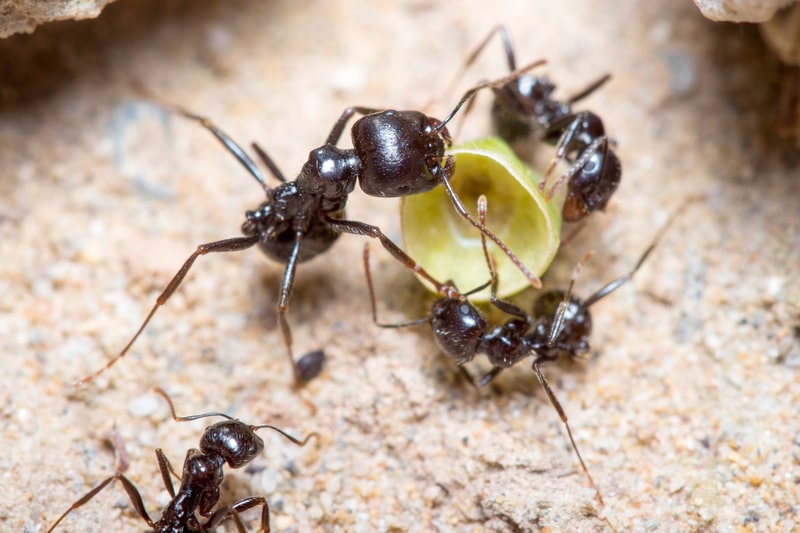
Harvester ants collect seeds for their primary food source, which is where they get their name.
There are 22 species in the United States, and the most common include:
The California harvester ant, Florida harvester ant, Red harvester ant, Black harvester ant, and the Western harvester ant.
Other than the Florida harvester ant, harvester ants are limited to the west of the Mississippi River.
This ant can be orange, red, or brownish-blank and grows to be ¼ to ½ inch; it has six legs and two sections.
Harvester ants are considered a nuisance pest because they’ll leave bare areas of soil in the grass. They’ll also eat the seeds from vegetable gardens and crops, causing them to die. Also, if the nest is disturbed, the harvester ant will sting, which can be deadly to very small animals. If you are stung by a harvester ant, it can cause a significant amount of pain that will eventually subside.
11. Asian Needle Ants

The Asian needle ant is native to Africa and has a very large, painful stinger, which is where this ant gets its name. The Asian needle ant is not only found in Asia and can be found in parts of the United States, including Alabama, North Carolina, South Carolina, Florida, Tennessee, Georgia, Virginia, Connecticut, and New York. if you live in any of these states, it’s best to avoid the Asian needle ant to prevent being stung.
Asian needle ants can live in disturbed and natural areas, unlike most pest ants. Most other types can live only in natural environments.
You can find these ants in kitchens, school cafeterias, and anywhere there’s food. Outside, you can find the Asian needle ant in the yard, fields, and national parks.
The ant is shiny black or dark brown. The workers can grow to 5 millimeters long, and the queen gets much larger and can grow to be 6.5 millimeters.
This ant feeds on termites, arthropods, and other invertebrates, including different types of ants.
This ant can cause harm in many ways:
*The Asian needle ant has a venomous sting that can be very painful and can cause an allergic reaction in some people, particularly those who are sensitive or allergic to insect bites and stings.
*The ant can infest homes, often living in areas of buildings where they’re close to a food and water source. They can contaminate your food and will require help from a professional to eradicate the infestation.
*This ant can devastate the natural environment.
These ants eat other ants that eat other insects. When they eat other ants, the population of nuisance insects can increase. Eating termites and other types of ants can disrupt the ecosystem.
12. Crazy Yellow Ants

The yellow crazy ant is also known as the long-legged ant and is native to Asia and West Africa. They were later accidentally introduced to tropical areas around the world. They are also known to nest in cinnamon, coffee, citrus, and coconut plantations, affecting the crops.
You can also find them on the ground, but never in trees.
The ant has an erratic walking style and will move frantically when disturbed, which is where the name came from.
The ant is yellow to brownish in color and grows to be around 5 millimeters long.
Fortunately, this ant has generalized nesting habits and can be dispersed using trucks, boats, and other forms of human transport. They can also naturally disperse through budding. When a queen mates, she will take some workers and establish a new colony.
The crazy yellow ant is a scavenging insect and has a broad diet.
They eat seeds, grains, arthropods, vertebrate corpses, and decaying matter. They are also known to attack and feed on small isopods, mollusks, land crabs, earthworms, and insects.
13. Acrobat Ants

There are 25 species of acrobat ants in the United States and over 400 species worldwide.
They get their name because when the nest is disturbed, they run around with their tails arched over their heads, similar to an acrobat’s move.
This ant grows to be 5.4 millimeters long, and many species emit a foul odor when disturbed.
The ant prefers to nest in moist, decaying wood. When the ant nests in a tree, it will take over the chambers of termites, beetles, caterpillars, and other wood boring insects. You can also find these ants inside rotten logs, under rocks, or other objects on the ground.
Although acrobat ants live outside, they will travel into houses looking for food and water.
Acrobat ants are often found in pine forests in the southeastern United States and are a significant food source for the red-cockaded woodpecker, which is an endangered species.
These ants eat various things, and their favorite is the honeydew excreted by aphids and mealy bugs. They also eat dead and live insects, sweets, and proteins found in homes.
14. Pyramid Ants
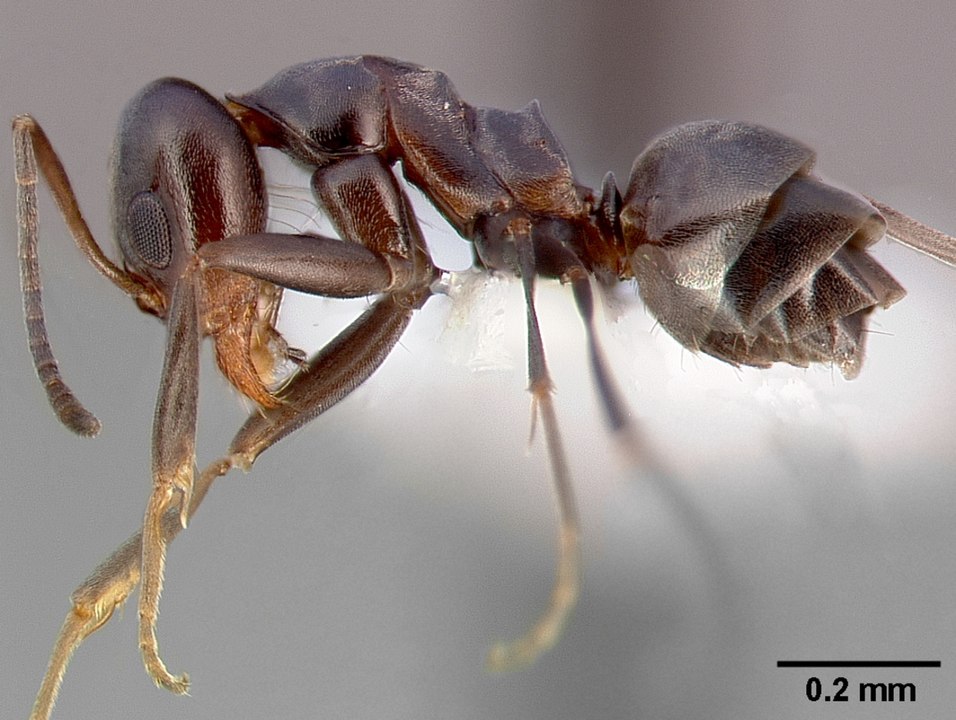
Pyramid ants get their name because the thorax is shaped like a pyramid.
The ant is around 1/8 inch long, and the head and thorax can be brown or reddish black, with a black abdomen.
The pyramid ant is found throughout the United States but is most common in the southern states.
This ant prefers to build nests in dry, sandy soil, often in open areas. Some will create a nest underground if the yard is already infested.
The nests are made by workers and are shaped like a volcano with an entrance on the top. Nests are built outdoors, but the ants may come into the house when foraging for food.
Pyramid ant colonies are smaller than other types of ants, and the colony contains one queen and a few thousand workers.
The pyramid ants’ primary food source is the honeydew produced by aphids, and they have a fondness for sweets. When foraging for food in the home, they’ll look for sugar, syrup, cake, and just about anything to curb their sweet tooth.
Pyramid ants aren’t aggressive but will bite if they feel threatened. They will also give off a rotten-coconut smell when they are disturbed or crushed.
15. Field Ants
Field ants are large ants and can grow to 4 to 8 millimeters long. The color varies, and they can be brown, black, yellowish, or bi-colored black and red.
This ant got its name because they prefer to nest out in the open. You can find field ants in lawns, gardens, and fields. Field ants don’t try to get indoors but are often seen around houses and other structures.
These ants build large mounds in open areas that can be three to four feet wide and up to two feet tall and build their nests with leaves, grass, small twigs, and pine needles.
Field ants don’t sting but will bite if disturbed. The bites can be very painful, particularly if the ant sprays. Some species spray formic acid into the wound after biting, making it more painful.
Fortunately, the pain will subside, and there are no long-term consequences, but if you have an allergy to insect bites, the bite can become inflamed and will be more painful.
Field ants live on honeydew they get from mealybugs and aphids. Some species keep herds of aphids in the nest, so they always have a supply of honeydew.
